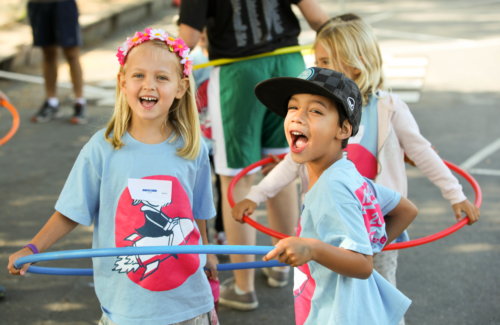Using Gamification In the Classroom and Out to Inspire Learning in Kids

Mary Poppins said it best: “You find the fun and snap! The job’s a game.” The truth is, we’re generally more willing to play than work, every time. That’s why more and more people are transforming their work through gamification. By turning tedious tasks into games people become more productive and feel more satisfaction. Adults are doing it at work, and kids are doing it at school. So why not try it with your kids at home?
Gamification means using games to teach, motivate and encourage creativity. It reduces fear of “scary” or intimidating subjects, like math or spelling. It turns an obligation students are forced to do into something they want to do. It challenges them, meaning learning is no longer a passive activity, but a set of small, achievable tasks kids are rewarded for completing. It’s inspirational and engages kids by immersing them in an experience, capturing their full attention.
In short, gamification is fun, easy and it works. So let’s take a look at how tasks are gamified at school and how to use those same techniques at home.
How Gamification in the Classroom Works
Human beings are motivated to play games by two basic drives. Some people care about how others judge them and rate their abilities. In short, they’re competitive. Others want to master their own proficiency. These are people who want to improve until they are at their personal best. Students tend to fall into these categories, too.
Many games work by giving a reward every time a task is completed to satisfaction. A game you can’t put down gives an ongoing series of rewards, that may increase in value as tasks slowly become harder. This is great for teaching kids because it mirrors how brains learn. And if you take this “piece by piece” approach to inputting information into a kid’s brain, they can learn almost anything.
So what techniques do schools use to harness the power of gamification? They offer rewards. Rewards can include points, achievement badges or levels, the filling of a progress bar or virtual currency. For example, kids could get a ticket every time they get an “A” on a test, then spend the tickets on prizes.
Competitive kids are motivated when their accomplishments are visible to others, such as by posting them on progress boards. For example, say a teacher wants their students to read more books. They can post a leaderboard showing the number of books each kid has read. Then, a reward can be given for reading a book, like a sticker, privilege or treat. By showing each kid’s progress, kids can compare their own number of books read, and try to beat other students’ “scores.”
Gamifying Household Chores
So how can you apply this same idea at home? Let’s take a common chore to gamify: washing dishes. It’s generally no one’s favorite task. But what if we broke it down dish by dish? Every time your kid washes a dish, remind them they’ve got one less dish left to wash. You could sing a little song, do a little dance or give them a high five. Or you can compare how many dishes they’ve washed on one night versus how many they wash on another.
Immersion is another part of gamification, and we know kids have big imaginations. If your kid can imagine they are fighting monsters on their journey to transform Sink-land into a clean home for the villagers, they’ve not only got a career ahead of them as a writer, but the job can feel like play time.
Once all the dishes are clean, give your kid a reward. It can be television, computer or phone time, granting some other privilege or giving them a credit toward their allowance. Then think of ways to gamify long-term work or “progress,” which will make washing dishes less of a nightly struggle. For example, if your kid washes the dishes every night of the week without complaining once, give them a reward that’s greater in value than their nightly reward. They could get an achievement badge. Then once they have a certain number of badges, they can get a big prize, like a visit to their favorite restaurant, theme park or a new toy or game.
Galileo’s Virtual Reality and Drone Innovators Majors
You know what else has outstanding potential for unlocking kids’ creativity? Teaching them how to create their own virtual reality or even how to program their own drone to carry out missions in a simulated city. Your kid’s brain is wired to pick up new skills and ideas, and the younger they start the more easily they will catch on. They may not have time during the school day to learn about game design as a subject or time after school to pursue it as a hobby on their own. That’s why summer camp is the perfect place to get them interested in game design and to teach the basic skills they’ll need to get started.
Galileo has two majors that ease kids into game design: Virtual Reality and Drone Innovators. In the Virtual Reality major, kids will create their own immersive virtual story. They’ll design a custom VR environment, use high-definition mobile devices to experience the world they’ve built in CoSpaces and share their own story with other kids. In the Drone Innovators major, your kid will learn how to program a Parrot Mambo quadcopter to carry out real-world missions from obstacle course navigation to disaster relief, and they will get demo their ideas in a realistic, simulated city.
At the end of both of these programs kids will have their own working game they can share with friends and family. They’ll have mastered the basics, and they can then continue developing these skills at home. And it will give them an intuitive understanding of the game development process, which will help even if they go into IT-related fields beyond game development. But most of all, they’ll have a fun activity that engages them with new friends, every day at camp. And isn’t that what being a kid is really about?
With Gamification Everyone’s a Winner
Using gamification at home can help get chores done and increase learning. This helps home life run smoother. Not to mention, they’re a great way for families to bond over something fun and educational. Try gamifying one of your kid’s chores at home today. When kids learn that work can be fun and rewarding, they’ll have a better attitude that makes success come more easily later in life.
If you’re interested in helping your kid take their game design skills to the next level, check out our summer programs in the San Francisco Bay Area, Southern California, and Chicagoland. Sign up for our mailing list to keep up-to-date on our camp happenings, innovation resources and registration information for our upcoming 2019 camp season.

